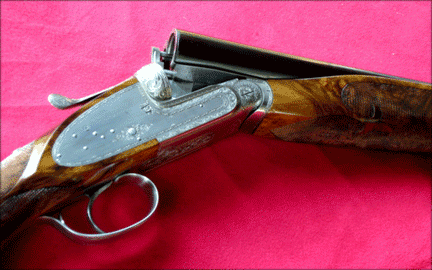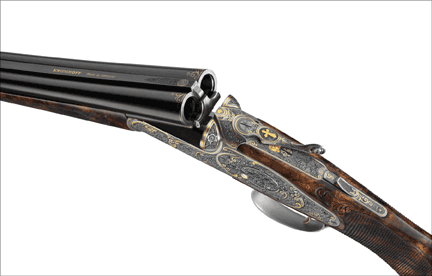Krieghoff’s Extraordinary “Tiflis” Live Pigeon Shotgun
The owner wouldn’t let us reveal his name, but shared with us everything else he knew about the rare Krieghoff Tiflis pigeon gun.
In a way, the Tiflis belies the popular notion of a shotgun classic. Although it is a side-by-side sidelock, it doesn’t date back to the 18th or 19th centuries. It was built in 1986 – but only 20 specimens were produced, all of them in 12 gauge, catapulting the Tiflis into the rarified world of limited-production Krieghoffs.
This small production run sheds light on Krieghoff’s evolution in sidelocks starting with the first Tiflis from the 1920s, up to the 1986 Tiflis, continuing to the current side by side called the Essencia.

Die shöne Schwester des Drillings „Nettune“ translates into “The pretty little sister of the drilling Neptune,” which is how Krieghoff described the Tiflis in this circa 1920 catalog drawing.
Legend:
- sideplate
- hammer
- hammer sear
- hammer spring
- trigger sear
- the according spring to that part – the trigger spring
- n/a the big part with the screws in it
- no h
- hammer pivot pin.
The 1986 Tiflis is a lookalike of a side by side manufactured by Krieghoff prior to World War II, with the exception that the first Tiflis sported articulated double triggers. The earliest evidence of the original Tiflis dates back to the 1920s, where it appeared in a now-obscure, 80-page Krieghoff catalog of shotguns, rifles and accessories (Hauptkatalog XXVII). Aside from the catalog’s etching and marketing copy written in German, the first Tiflis seems to have been largely forgotten.
Both the original and later model Tiflis are veiled in mystery. Even the good folks at Krieghoff didn’t have production numbers on the initial Tiflis, although we do know that the 1986 pigeon gun was discontinued for cost considerations; the marketplace wouldn’t support its development and ongoing manufacturing.
We discovered the 1986 Tiflis at the Southern Side by Side, April 24-26, 2009, held at the Deep River Sporting Clays & Shooting School in Sanford, North Carolina. After a hard day of shooting in a heatwave, we convened for a tailgate party thrown by our former columnist, Elizabeth Lanier. Amid the appetizers, cocktails and cigars that are the hallmark of Elizabeth’s hospitality, we struck up a conversation with a fine Southern gentleman to our left. Turned out, he was the owner of the Tiflis. He explained that he loved to shoot live pigeons with it and also took it to Scotland for driven pheasants.

While the rarity and value of a collectible Krieghoff is generally determined by the prestige of an engraver or perhaps a matching set of barrels, it’s unusual to find any Krieghoff that had a production run of only 20 guns – and a sidelock at that – as the 1986 Tiflis.
After exchanging several emails with the owner to obtain details on the 1986 Tiflis, we ran into him several months later at The Vintagers event in Queenstown Maryland, September 24-27, 2009, where aficionados of Edwardian guns and fashions stage a competition of classic side by sides. We immediately asked if he had the Tiflis with him and if we could see it. Of course he obliged.
He led us to his SUV where the removed the Tiflis from a built-in vault in the cargo compartment. He carefully withdrew the fully restored side by side from a case and handed it to us. While the original pre-war Tiflis weighed about 6.5 pounds, this one felt a little heavier – closer to 7-plus pounds. It did not come up as quick as an English field gun, instead communicating everything Krieghoff in terms of heft, confidence and handling.

Compared to the newer Krieghoff Essencia, the 1986 Tiflis looked like a bulkier side by side. Perhaps it was the perpendicular angle of the frame versus the Essencia’s round body, or the Tiflis’ less elegant proportions. Still, the Tiflis was magnificent. The four-pin sideplate possessed a genuine authority as a time-honored pigeon gun, while the single trigger, nitride receiver and vented rib gave the Tiflis a thoroughly modern look.
The finished product in my hands was the result of a team effort to restore the shotgun that was initially purchased through a quick phone call to Dave Riffle Gun Sales in Fort Meyers, Florida.
“A very good shooting buddy knows of my intense fondness for shooting live pigeons and for Krieghoff guns,” the owner related. “He found the Tiflis advertised on Dave Riffle’s website one morning and sent me an e-mail with a direct link to the website and to the very gun. His e-mail said, simply, you have to buy this gun and 20 minutes later, I had.”
The furniture and barrels received immediate attention as part of the shotgun’s restoration.
Tom Smith of Weston, Ohio fashioned a fitted Circassian walnut stock. The 30-inch barrels (originally choked full/full) had been sent to Briley Manufacturing in Houston, Texas after the owner patterned the gun and saw that it shot 0/100 – meaning that the point of impact was below dead flat. Fortunately, there was enough steel in the 30-inch barrels so that Briley could drill the inside diameter at a slight upwards angle and change the point of impact to 50/50. The owner also asked Briley to thread the muzzles for flush-mounted, interchangeable chokes.

Because of the shotgun’s short production run, spare parts were non-existent. When a leaf spring broke in the action, the owner had to send the Tiflis back to Krieghoff in Germany to have a replacement made from raw steel stock.
“The Tiflis has all the wonderful characteristics of the other Krieghoff shotguns,” the owner explained. “It has tight, crisp triggers, impeccable workmanship, and is reliable and steady. And, it has some of the non-English features which I particularly enjoy: single triggers, ejectors, pistol grip and beavertail forearm. If I do say so, it is a handsome gun and a reliable companion in the field.”
As it turns out, the owner’s passion for the Tiflis reflects the marketing narrative provided by Krieghoff in the circa-1920s catalog. Alex Diehl, General Manager of Krieghoff, helped translate that early Krieghoff copy from the original German.
The word Tiflis is actually German for partridge gun.
In reviewing the catalog, Alex noted that Krieghoff had marketed the Tiflis to elegant gentlemen who wore ties and proper shooting attire.
“It is the lightest and most elegant and best pointable, self-cocking shotgun,” the catalog read. Alex added that at the time a self-cocking gun was somewhat of an upgrade.
Continuing with his catalog translation, Alex read “It is equipped with sidelocks. This well-known construction ensures very soft and crisp triggers due to the long hammer springs and also ensures easy cleaning due to the ability to detach the sidelocks from the gun and thereby supplying a maintenance advantage to the experienced hunter.”
The catalog detailed that “The lockup is the top lever lockup with a double-cut locking bolt.” (The Tiflis featured a Greener-style cross-bolt lock.)
In the cut-away engraving, the fences are called wings and are said to act as reinforcements to the locking apparatus.
“The safety is located on the left sidelock in shape of a turn switch,” the catalog said. “And it is superior to the standard push safety on the top tang for not only securing the triggers but actually securing the hammers themselves. If desired, the standard top tang push safety is available.”
The catalog further discusses the Tiflis safety features:
“To prevent the gun from doubling, which with the very soft and crisp trigger characteristics is a risk, both locks are equipped with a second so-called safety sear. This sear catches the hammer should it accidentally slip out of the hammer sear.”
In regards to the Tiflis’ double triggers, “The front trigger is equipped with a hinge so it can fold to the front should the recoil of the second shot push it against the index finger.”
The Tiflis was available in “German or English style and fine, hand-cut checkering on the pistol grip and forend.” Alex said that the German-style stock would have a pistol grip with the English style as a straight stock.

“Highly discriminating master gunsmith handwork guarantees the quality of this model,” the catalog said. “Its light weight, elegant, pointable shape makes it the first-class elegant gun for the discriminating hunter.”
The catalog listed the 16-gauge model weighting 2.7 kilos or about 6 pounds, with the 12 gauge at 2.9 kilos or about 6.4 pounds. “Heavier versions are available,” the catalog notes, for shooters sensitive to recoil.
The Tiflis was priced at 380 Reichsmark, the currency introduced in 1924 (helping date the catalog). Alex observed that 380 Reichsmark was “a lot more than a month’s salary for a worker,” underscoring the Tiflis’ exclusivity.
Ejectors were listed as an option and in reading the catalog Alex saw that the extractors were actually called a “cartridge out-thrower” incorporated into each barrel. Ejectors cost approximately 90 Reschsmark or some 25% of the price of the Tiflis.
Other options listed in the catalog included corrosion-resistant barrels (standard barrels were made of expensive Buhler steel) and a single trigger. The corrosion-resistant barrels cost about 190 Reichsmark.
Having Alex translate the Tiflis catalog copy for us was a true revelation in following the evolution of this rare sidelock from Krieghoff. It also shed light on the Krieghoff Essencia that we had previous reviewed (please click here).
So while the Tiflis remains out of reach for most of us, the Essencia represents the latest thinking in Krieghoff’s approach to a sidelock bird gun, which started back with the original Tiflis.
Irwin Greenstein is Publisher of Shotgun Life. You can reach him at letters@shotgunlife.com.
Useful resources:

Irwin Greenstein is Publisher of Shotgun Life. Please send your comments to letters@shotgunlife.com.


Comments